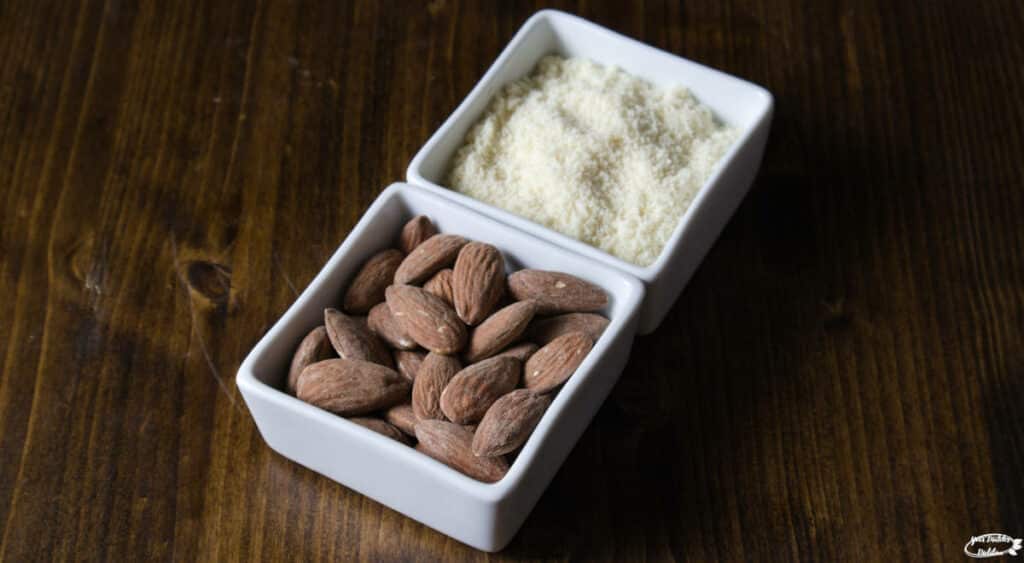With the abundance of keto and gluten free products out there, almond flour has become more widely available. You’ve probably seen it in baking mixes and as a base for crackers, cookies, and pancakes.
So you might be wondering, is almond flour better than all of the other flours used to make delicious baked goods? Is almond flour good for diabetes? Almond flour is more expensive than regular baking flour, so is it worth it?
Let’s take a look at whether almond flour is good for diabetes, along with its nutrition facts and health benefits. Read on to also find out which flour is the best for diabetes!
DISCLAIMER: This post was written by Justine Chan MHSc, RD, CDE. All content on this site is for informational purposes only and is not a substitute for professional medical or nutritional advice. Always seek medical and dietary advice from your doctor or dietitian.

All nutrition information is sourced either through food labels or through the USDA Nutrient Database.
Table of Contents
Nutrition
¼ cup (28g) of almond flour provides:
- 165kcal
- 5 grams of carbohydrates
- 3 grams of fiber
- 7 grams of protein
- 14 grams of fat
- 66mg of calcium (5% Daily Value)
- 1mg of iron (5% Daily Value)
- 72mg of magnesium (17% Daily Value)
- 191mg of potassium (4% Daily Value)
- 0.85mg of zinc (7% Daily Value)
- 0.2mg of vitamin B2 (15% Daily Value)
- 7.2mg of vitamin E (50% Daily Value)
As you can see, almond flour is mostly fat, which makes up 75% of the calories. It’s also high in some key vitamins and minerals that play a role in managing blood sugars, healthy skin and immune health.
How is almond flour made?
The only ingredient in almond flour is blanched almonds, which means the skin was removed as the almonds were boiled. The flour is made by grinding the almonds to make the texture more fine and smooth.
With a high speed blender or food processor, you can make them on your own using the same process.
You may have seen or heard about almond meal and wondered what’s the difference. Almond meal is made from raw, unpeeled almonds so the texture is more coarse.
Probably not as good as almond flour for cakes and cookies, right?

Does almond flour increase blood sugar?
Because almond flour is very low in carbs, it shouldn’t affect your blood sugars. A randomized controlled trial involving 32 people on a low carb diet found that when either almonds or peanuts were added, both were effective in improving fasting and after meal blood sugars (1).
However, another systematic review found no real difference on fasting and after meal blood sugars, but did find almonds were effective in lowering HbA1c and weight (2). HbA1c is your average blood sugar over the past 3 months, as measured by a blood test.
Almonds may also promote healthy gut bacteria (2), which has been linked to many benefits including improved blood sugars, weight management, lower cholesterol, and protecting your immune system (3).
Also, because almonds are highest in fiber compared to other nuts, this helps with slowing down the digestion and absorption of sugars and starches. Slower digestion means less blood sugar spikes as shown in randomized controlled trials.
For example, combining almonds with white bread lowered blood sugars afterwards by up to 14% compared to white bread alone, according to a 2021 comprehensive review (4).
Considering its minimal impact on blood sugars and a host of the other benefits, it is hard to argue against almond flour being a great choice for people with diabetes!
What is the lowest carb flour?
Here is a list of commonly used flours from lowest to highest carb, per 100g:
| Flour (per 100g) | Calories (kcal) | Carbs (g) | Fiber (g) | Protein (g) | Fat (g) |
| Almond | 578 | 16 | 9 | 26 | 50 |
| Chickpea | 387 | 58 | 11 | 22 | 7 |
| Coconut | 429 | 64 | 36 | 21 | 11 |
| Oat | 389 | 70 | 10 | 13 | 6 |
| Whole Wheat | 370 | 71 | 11 | 15 | 3 |
| Spelt | 364 | 71 | 9 | 15 | 3 |
| All Purpose | 364 | 76 | 3 | 10 | 1 |
| Brown Rice | 363 | 77 | 5 | 7 | 3 |
As you can see, almond flour is by far the lowest carb option. The second lowest carb option, chickpea flour, has around 3.5 times the carbs of almond flour!

Which flour is the best for diabetes?
There is no definitive evidence to say any one flour is the best. However, when looking for a flour that’s good for diabetes, there are a few important things you want to look for.
You generally want a flour to be:
- Low in calories
- High in fiber
- High in protein
- Whole grain
- Low in saturated fat
While no flour will necessarily check all the boxes, one that’s whole grain is going to give you more fiber and vitamins compared to one that’s refined.
The benefits of whole grains are well established. They have been shown to reduce your risk of type 2 diabetes and lower post meal blood sugars more than refined grains (5). Whole grains can also improve cholesterol, HbA1c, and inflammation, according to a 2020 systematic review and meta analysis (6).
Based on the above macronutrients for all the various flours and my professional experience, my top three would be almond flour, chickpea flour, and whole wheat flour. These flours rank at the top for fiber and protein, both key factors that will determine your blood sugar response and how full you will feel.
Health Benefits
Since almond flour is made entirely of almonds, most of the health benefits below relate to almonds. Compared to other nuts, a serving of almonds contains the most fiber, healthy monounsaturated and polyunsaturated fats, and antioxidants (4).
Cholesterol
Did you know almonds can lower your cholesterol, especially if it’s high to begin with? So just how much is effective? A 45g portion, or roughly a half cup daily, was found to have the largest impact on total cholesterol and LDL, aka your “bad” cholesterol, based on a 2021 comprehensive review (4)
Blood pressure
When we look at what randomized controlled trials are telling us, there is some evidence that almonds may reduce blood pressure (7, 8). How? It’s hard to tease out exactly, because almonds contain healthy fats, vitamins, minerals such as magnesium and potassium, fiber, plant sterols, polyphenols, and antioxidants, all of which may play a role (7).

Also, the fiber in almonds helps to feed your good gut bacteria, and in doing so can help to regulate blood pressure (7).
If you are looking for more ways to help lower your blood pressure, beets are another great food that can excel at this.
Gut health
While the research on almonds and gut health is still in its early stages, there is growing evidence to show that the fiber in almonds is prebiotic. This means they feed the good bacteria in your gut and decrease the bad ones.
Why is this important? Well, more specifically, the fiber in almonds helps feed short chain fatty acid producing bacteria. An increase in this type of bacteria is known to play a role in managing your appetite, blood sugars and weight, among many other things (4).
Weight
You may be thinking almonds are high in calories so eating them can cause weight gain. Actually, it’s been consistently shown that almonds can help reduce weight and percentage body fat (4, 9).
Since low calorie diets are often low in fiber, which results in less food for your gut bacteria, it’s been speculated that almonds can counteract this negative effect. As noted above, this type of gut bacteria is beneficial for managing your appetite and weight.
Side effects and indications
Almond flour is gluten free. Great news if you have celiac disease!
Since almonds are a tree nut, they are a common allergen that can cause a reaction.
Because almond flour is higher in fat and calories, digestion is slowed. You will feel more satisfied and full. As discussed above, your blood sugars may be more stable if eaten with a meal or as a snack.
Almond flour is considered to be a high potassium food at over 600 milligrams of potassium per 100g serving. If you have kidney disease, you may need to limit your intake of almonds and nuts in general.
Your kidneys act as filters, so when they aren’t working well, too much potassium in your diet can easily build up in your body, which can lead to a heart attack.
Almonds are also high in oxalates so if you’re prone to kidney stones, you may need to limit or avoid them.
If you’ve had kidney stones before, it’s best if you can confirm what type it is at the lab, but if not most kidney stones are made of calcium and oxalate crystals.
One of the best ways to lower your risk of kidney stones is to drink at least 10 to 12 cups of fluids daily. This is because when your urine is concentrated, it’s easier for crystals to form.
How to store and use almond flour
To keep almond flour from going bad, you can store it in the fridge for up to 12 months. In the pantry, you’ve got up to 4 months.

Almond flour can be used for:
- Breadcrumbs or as breading
- Baked goods such as muffins, scones, cookies
- Pancakes
- Breads
- Waffles
- Tortillas
- Pizza crust
- Meatballs
Baking ratio
One cup of almond flour can be used to substitute one cup of flour. Keep in mind, the flavor may be sweeter than your regular baking flour.
Key takeaways: Is almond flour good for diabetes
So far, this post has covered the nutritional profile of almond flour, how it stands compared to other common flours, and whether almond flour is good for diabetes.
Almond flour provides some great health benefits and is a versatile substitution for other flours in cooking and baking. Incorporating almond flour or nuts into your diet on a regular basis may help you to feel more satisfied, have lower cholesterol and blood sugars overall.
For more exclusive tips that I share with my email list only, be sure to sign up below!





hello!,I like your writing very much! share we communicate more about your post on AOL? I need an expert on this area to solve my problem. May be that’s you! Looking forward to see you.
I truly appreciate this post. I¦ve been looking everywhere for this! Thank goodness I found it on Bing. You have made my day! Thank you again